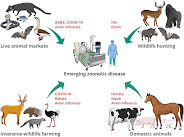Zoonoses are diseases that can be transmitted from animals to humans. They can be caused by bacteria, viruses, parasites and fungi. Zoonoses are a major threat to public health, causing millions of deaths each year.
How do people transmit viruses to animals?
Humans can transmit viruses to animals in a number of ways, including:
Direct contact: This can happen when people come into contact with the saliva, blood or other body fluids of an infected animal.
Indirect contact: This can happen when people come into contact with a contaminated surface or object.
Aerosols: This can happen when people breathe in aerosol particles of the virus.
Examples of viruses that humans transmit to animals
Influenza: Influenza is a virus that can cause respiratory illness in humans and animals. Humans can transmit influenza to animals through direct contact, indirect contact, or aerosols.
Measles: Measles is a virus that can cause a rash, fever, cough and runny nose. Humans can transmit measles to animals through direct contact or through aerosols.
Mumps: Mumps is a virus that can cause fever, headache, muscle aches and swollen parotid glands. Humans can transmit mumps to animals through direct contact or through aerosols.
Rubella: Rubella is a virus that can cause a rash, fever, and joint pain. A person can transmit rubella to animals by direct contact or through aerosols.
What are the consequences of the transmission of viruses to animals from humans?
When humans transmit viruses to animals, it can have a number of negative consequences, including:
Animal death: In some cases, viruses that are transmitted from humans to animals can be fatal.
Animal health problems: Viruses that are transmitted from humans to animals can cause a variety of health problems in animals, including respiratory diseases, reproductive problems and neurological disorders.
Economic damage: Zoonoses can cause significant economic damage to the agricultural industry.
Threats to public health: Zoonotic diseases can pose a serious threat to public health because they can be transmitted from animals to humans and cause outbreaks.
What can be done to prevent the transmission of the virus from a person to an animal?
There are a number of things that can be done to prevent the transmission of viruses from humans to animals, including:
Vaccination: Vaccinating people against zoonotic diseases can help protect both people and animals.
Education: Increasing awareness of zoonotic diseases and how to prevent them can help reduce the risk of transmission.
Biosecurity: Implementing biosecurity measures on farms and other animal handling facilities can help prevent the spread of disease.
One Health: A One Health approach that recognizes the interconnectedness of human, animal and environmental health is essential to prevent the transmission of zoonotic diseases.
Where can I find more information about zoonoses?
The following organizations provide information on zoonotic diseases:
World Health Organization
World Organization for Animal Health (OIE)
Food and Agriculture Organization of the United Nations (FAO)
Centers for Disease Control and Prevention (CDC)
What do you think? Do you have questions about zoonotic diseases? Please share your thoughts in the comments below.

Comments
Post a Comment